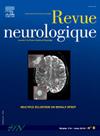比较阿尔茨海默病中高淀粉样蛋白和低淀粉样蛋白的产生:一项深入分析。
IF 2.3
4区 医学
Q2 CLINICAL NEUROLOGY
引用次数: 0
摘要
背景:脑脊液(CSF) a β42/40比值已被证明是阿尔茨海默病(AD)中淀粉样蛋白病理比CSF a β42更可靠的生物标志物,有助于正确分类tau生物标志物(T+)阳性的患者,否则这些患者将一直处于AD连续体之外。结果表明,a β42/40比值较好地反映了脑脊液a β高水平患者a β42的相对下降。然而,A+由Aβ42/40比值定义的高淀粉样蛋白(HiA) AD患者与A+仅由Aβ42定义的低淀粉样蛋白(LoA) AD患者是否完全相同,值得进一步分析。方法:我们回顾性地纳入了有认知和神经退行性改变(N+)证据的A+T+ AD患者。LoA患者手术定义为T+N+、CSF Aβ42低的患者,HiA患者定义为T+N+、CSF Aβ42正常、Aβ42/40比值异常的患者。比较HiA组和LoA组Tau脑脊液生物标志物、神经心理特征、认知能力下降率、结构和代谢成像、ApoE基因型和脑神经病理学。结果:腰椎穿刺时,LoA患者明显年轻于HiA患者(68.9±8.7岁vs. 71.8±9.4岁;P=0.0015),最小精神状态检查(MMSE)(18.7±6.4∶20.7±6.2;P = 0.0005)。两组早期阿尔茨海默病患者的神经心理特征和年认知能力下降率没有差异。在脑脊液Tau和P-Tau生物标志物、萎缩和脑代谢、APOE4等位基因分布和APOE4/E4基因型以及神经病理学方面,两组之间没有差异。结论:总的来说,我们的研究支持用Aβ42/40的比值作为Aβ42的等效物来定义AD。我们发现HiA脑脊液谱与认知、脑结构和代谢、APOE基因型tau脑脊液生物标志物或认知衰退率的差异无关,但可能与晚发和早期AD有关。本文章由计算机程序翻译,如有差异,请以英文原文为准。
Comparing high and low amyloid producers in Alzheimer's disease: An in-depth analysis
Background
The cerebrospinal fluid (CSF) Aβ42/40 ratio has proven to be a more reliable biomarker for amyloid pathology than CSF Aβ42 in Alzheimer's disease (AD), helping to correctly classify patients with positive tau biomarkers (T+) that would otherwise have remained outside of the AD continuum. It was shown that the Aβ42/40 ratio better captures a relative decrease of Aβ42 in patients with high CSF Aβ. However, whether patients with high-amyloid (HiA) AD, in whom A+ is defined by the Aβ42/40 ratio, exactly compare with their low-amyloid (LoA) counterparts, in whom A+ is defined by Aβ42 solely, deserves further analysis.
Methods
We retrospectively included patients with A+T+ AD and evidence of cognitive and neurodegenerative changes (N+). LoA patients were operationally defined as patients with T+N+ and low CSF Aβ42, while HiA patients were defined as patients with T+N+ and normal CSF Aβ42 but abnormal Aβ42/40 ratio. Tau CSF biomarkers, neuropsychological profile, rates of cognitive decline, structural and metabolic imaging, ApoE genotype and brain neuropathology were compared between the HiA and LoA groups.
Results
At the time of the lumbar puncture, LoA patients were significantly younger than the HiA patients (68.9 ± 8.7 years vs. 71.8 ± 9.4; P = 0.0015) and had a lower Mini-Mental Status Examination (MMSE) (18.7 ± 6.4 vs. 20.7 ± 6.2; P = 0.0005). There was no difference in the neuropsychological profile nor in the annual rates of cognitive decline between the two groups with early AD. No differences were retrieved between groups on CSF Tau and P-Tau biomarkers, atrophy and brain metabolism, distribution of the APOE4 allele and APOE4/E4 genotype, and neuropathology.
Conclusions
Overall, our study supports the surrogate use of the Aβ42/40 ratio as an equivalent to Aβ42 to define AD. We showed that HiA CSF profiles were not associated with differences in cognition, brain structures and metabolism, APOE genotype tau CSF biomarkers or the rates of cognitive decline, but may be the associated with later-onset and early-stage AD.
求助全文
通过发布文献求助,成功后即可免费获取论文全文。
去求助
来源期刊

Revue neurologique
医学-临床神经学
CiteScore
4.80
自引率
0.00%
发文量
598
审稿时长
55 days
期刊介绍:
The first issue of the Revue Neurologique, featuring an original article by Jean-Martin Charcot, was published on February 28th, 1893. Six years later, the French Society of Neurology (SFN) adopted this journal as its official publication in the year of its foundation, 1899.
The Revue Neurologique was published throughout the 20th century without interruption and is indexed in all international databases (including Current Contents, Pubmed, Scopus). Ten annual issues provide original peer-reviewed clinical and research articles, and review articles giving up-to-date insights in all areas of neurology. The Revue Neurologique also publishes guidelines and recommendations.
The Revue Neurologique publishes original articles, brief reports, general reviews, editorials, and letters to the editor as well as correspondence concerning articles previously published in the journal in the correspondence column.
 求助内容:
求助内容: 应助结果提醒方式:
应助结果提醒方式:


